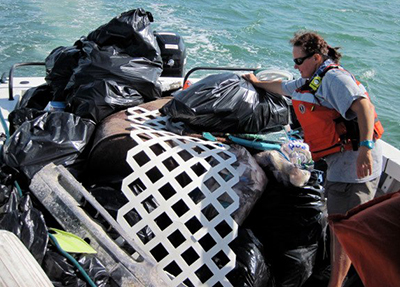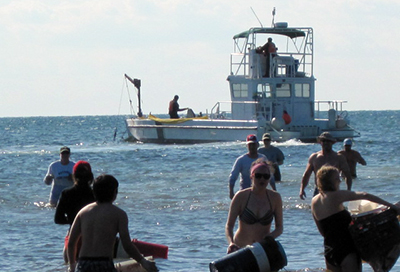
Park hosts Alternative Break cleanup
HOMESTEAD, Fla. – While some college students spend their spring break partying on South Beach, others prefer to use the week off to be productive. Biscayne National Park’s (BNP) Alternative Break program offers these students the opportunity to participate in a nationwide initiative to commit to “a substance-free, service-oriented experience.”
The program aims to remove the debris that washes ashore on the park’s sea turtle nesting beaches. Most of the litter found on the property includes plastic and glass bottles, shoes, light bulbs, shipping pallets, furniture and boating gear, according to BNP fishery and wildlife biologist Vanessa McDonough.
| Volunteers collected more than 700 pounds of marine debris. The litter was hauled by boat to a dumpster on the mainland (Photo courtesy of Coastal Cleanup Corporation). |  |
“This trash creates insurmountable impediments for sea turtles that come ashore from May to October to lay nests on our beaches,” McDonough said. “A sea turtle that encounters these obstacles abandons her nesting attempt and returns to sea.”
BNP staff leads the cleanup while students are in charge of most of the manual labor. The staff offers a basic orientation of the park as well as sea turtle nesting at BNP. They also equip each volunteer with a life jacket, sunscreen, dive booties and bug spray.
The group then takes park vessels out to the nesting beaches on both the oceanside and bayside of Elliott Key. On site, the students are given materials necessary for the cleanup, such as grabbers, protective gloves and trash bags.
The program is designed as a one-day event, but the length usually depends on the group.
“Some can only come for one day, others complete cleanups for multiple days in a row,” McDonough said.
The groups vary in size. Smaller groups typically consist of six students, while the average group consists of 10 to 12 volunteers. Groups as large as 20 to 30 can be accommodated. At least two staff members from BNP are usually present.
“We are lucky in that we do not have to actively seek out volunteers,” McDonough said. “With the Alternative Break program being fairly well-established, BNP is on the radar screen already for many of the school groups.”
Since the participants are college – or sometimes, high school – students, the Alternative Break program typically takes place in March when the students are available during spring break. However, the date changes to work around the student groups’ schedules.
 |
University of Wisconsin student volunteers shuttle trash offshore to a Biscayne National Park vessel (Photo courtesy of Coastal Cleanup Corp.). |
If a large number of students are participating, mangrove shoreline or snorkeling cleanups are scheduled in addition to the usual cleanups in the sea turtle nesting beaches.
In 2013, 212 students – representing 18 schools – participated in 2,832 hours of service for BNP’s cleanups.
“The sheer volume of trash removed from the beaches is astounding,” McDonough said. “In 2013, at least 100 cubic yards of trash was removed and this does not factor in all of the recyclable items, which were discarded separately ….”
Coastal Cleanup Corporation (CCC) co-founder Suzy Pappas – who has been involved with the BNP program since the spring of 2012 – says the program can be impactful for participants.
“It is always interesting to see the shocked facial expressions of the new volunteers when they first arrive at the island and are stunned to see the massive amount of marine debris that has washed up on Elliott Key,” she said. “Many of the student volunteers indicate that they will never use plastic water bottles, plastic cutlery or helium balloons again.”
Suzy Pappas and CCC co-founder George Pappas help BNP transport students by boat to Elliott Key for the cleanups. They also supervise the students, pack up and weigh the debris and even fund fuel and provide equipment.
“The program is a great opportunity for college students to make a difference in restoring the coastal environment and providing a suitable habitat for endangered loggerhead and green sea turtles to nest,” Pappas said.
For more information or to participate in the Alternative Break program, call Vanessa McDonough at 305-230-1144 (ext. 027) or send e-mail to vanessa_mcdonough@nps.gov.

Comments are Closed